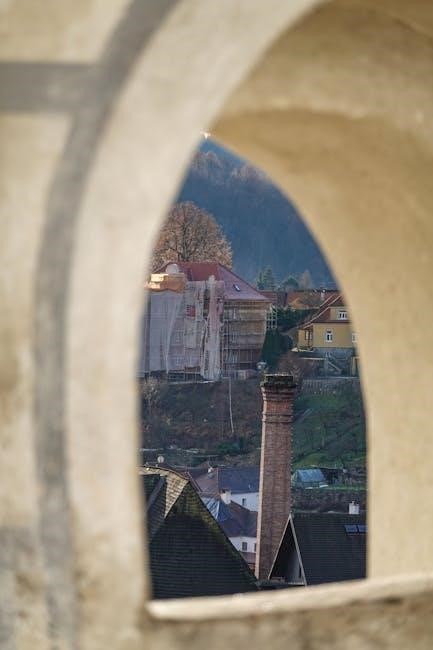The biblical narrative unfolds as a grand story of God’s relationship with His creation, encompassing creation, fall, redemption, and restoration. These themes, interconnected and central to Scripture, reveal God’s sovereignty, humanity’s condition, and the ultimate hope of restoration through Jesus Christ, providing a framework for understanding the divine plan.
1.1 Overview of Creation, Fall, Redemption, and Restoration
The biblical narrative is structured around four key themes: creation, fall, redemption, and restoration. Creation highlights God’s original design of a perfect world, while the fall introduces sin and its consequences. Redemption, through Jesus Christ, addresses the brokenness, offering salvation and reconciliation. Restoration envisions the ultimate renewal of all things, restoring God’s creation to its intended glory and harmony. This framework provides a comprehensive view of God’s plan and humanity’s journey.
1.2 The Significance of Understanding the Biblical Metanarrative
Understanding the biblical metanarrative—creation, fall, redemption, and restoration—provides a unified framework for comprehending God’s plan and humanity’s purpose. It reveals the interconnectedness of Scripture, offering insight into God’s sovereignty, humanity’s condition, and the ultimate hope of restoration. This overarching story grounds believers in their faith, shapes their worldview, and inspires living in alignment with God’s redemptive purposes, both individually and communally, fostering transformation and hope.
Creation: God’s Original Design
God created a perfect world, establishing humanity as His image-bearers, entrusted with stewardship. Creation reflects His glory, love, and wisdom, designed for harmony and flourishing under His care.
2.1 The Creation Story in Genesis 1-2
Genesis 1-2 recounts God’s creation of the world in six days, culminating in the seventh day of rest. God spoke, bringing forth light, land, sea, and life, declaring all “very good.” Humanity, created in God’s image, was placed in the Garden of Eden to steward creation and enjoy fellowship with Him. This foundational narrative establishes God’s sovereignty and humanity’s unique role.
The creation story emphasizes God’s intentional design, from the ordered universe to the sacredness of human life. It highlights harmony, purpose, and the divine relationship between Creator and creation, setting the stage for the biblical metanarrative.
2.2 Humanity as Image Bearers of God
Genesis 1:26-27 reveals humanity as uniquely created in God’s image, male and female alike. This divine imprint grants humans dignity, moral responsibility, and the capacity for relationship with God and others. Bearing God’s image means reflecting His character, such as love, wisdom, and justice, and carrying out His mandate to steward creation. This identity underscores humanity’s sacred value and purpose in God’s original design.
2.3 The Role of Stewardship in Creation
God entrusted humanity with the responsibility of stewardship over creation, as seen in Genesis 1:28. This involves managing and caring for the earth’s resources wisely. Stewardship reflects humanity’s role as God’s image bearers, emphasizing faithfulness and accountability. It underscores the importance of preserving and sustaining creation, aligning with God’s original design and intent for the world. This role highlights humanity’s partnership with God in maintaining His creation.
The Fall: Rebellion and Its Consequences
The Fall marked humanity’s rebellion against God, introducing sin and disrupting the harmony of creation. It led to spiritual and physical death, fracturing relationships and causing suffering.
3.1 The Nature of Sin and Rebellion
The Fall introduced sin, a fundamental rebellion against God’s authority, rooted in humanity’s desire for autonomy. This disobedience severed the perfect relationship with God, leading to a corrupted nature and a world under a divine curse. Sin’s essence is opposition to God’s will, manifesting in self-centeredness and moral failure, with far-reaching consequences for humanity and creation. It disrupted harmony, introducing suffering and death.
3.2 The Effects of the Fall on Humanity and Creation
The Fall resulted in humanity’s separation from God, introducing spiritual and physical death. Creation, once flawless, was cursed, leading to suffering and chaos. Humanity’s relationship with God and creation was fractured, causing moral corruption and relational dysfunction. The natural world became subject to decay, reflecting the consequences of sin. This cosmic impact underscores the severity of rebellion against God’s design, affecting every aspect of existence and relationships.
Amidst the Fall’s devastating consequences, God introduced the promise of redemption. The serpent’s defeat was foretold, hinting at a future Savior. This divine plan, rooted in grace, laid the foundation for humanity’s rescue from sin’s grip. The introduction of redemption in the Fall signifies God’s unwavering commitment to restore His creation, offering hope and a path to reconciliation through His ultimate plan of salvation and restoration.
Redemption: God’s Plan to Rescue Humanity
Redemption is God’s sovereign plan to rescue humanity from sin’s consequences, restoring relationship with Him. Through Christ’s death and resurrection, sin’s curse is overcome, offering forgiveness and eternal life.
4.1 The Promise of Redemption Through Jesus Christ
The promise of redemption through Jesus Christ is central to God’s plan, fulfilling the divine purpose to reconcile humanity. Christ, as the Second Adam, restores God’s original design, offering salvation from sin’s corruption. Through His sacrifice, believers are justified, and creation’s redemption begins, reflecting God’s love and sovereignty. This promise ensures eternal restoration, uniting all things in Christ.
4.2 The Atonement and Its Implications
The atonement, achieved through Christ’s sacrificial death, addresses the consequences of humanity’s rebellion, restoring relationship with God. It demonstrates divine love and justice, satisfying the penalty for sin. Through this act, believers are justified, reconciled, and empowered to live anew. The atonement also initiates creation’s renewal, reflecting God’s redemptive plan to restore all things, ultimately leading to eternal harmony and glory.
4.3 The Restoration of Relationship with God
The restoration of humanity’s relationship with God is central to redemption, achieved through Christ’s sacrifice. This reconciliation reestablishes intimacy with God, enabling believers to experience His presence and guidance. Through faith in Jesus, individuals receive new life in the Spirit, empowering them to live in harmony with God and others. This restoration is both a present reality and a future hope, reflecting God’s desire for eternal fellowship with His people.

Restoration: The Ultimate Hope
Restoration is the ultimate hope, representing God’s plan to renew creation and restore all things through Christ. It signifies the triumph of God’s redemptive plan, bringing eternal harmony and peace.
5.1 The Present Reality of Restoration
Restoration begins now through faith in Jesus, transforming individuals and communities. It involves spiritual renewal, reconciling relationships, and living out kingdom values. Believers are called to steward creation and bring God’s redemptive work into the world, reflecting His love and justice. This present reality is a foretaste of the future restoration of all things.
5.2 The Future Hope of a Restored Creation
The ultimate hope is a fully restored creation where God dwells among His people. The New Heaven and New Earth symbolize a world free from sin and suffering. All things will be made new, with no more death or pain. This future restoration brings eternal life in God’s presence, fulfilling His promise of redemption. It is the final triumph of God’s plan, where creation is fully reconciled to its Creator;
5.3 The Role of the Church in Restoration
The Church plays a vital role in God’s restoration plan by embodying His kingdom on earth. Through Christ, believers are called to be agents of reconciliation, spreading God’s love and justice. The Church’s mission involves spiritual and social transformation, fostering unity among diverse peoples. By living out the gospel, the Church ushers in glimpses of the restored creation, reflecting God’s redemptive work in the world.
Cosmic Redemption and Restoration
God’s plan extends beyond humanity, renewing the natural world and restoring creation from the effects of the fall, fulfilling His promise of cosmic redemption and eternal harmony.
6.1 The Redemption of the Natural World
The natural world, affected by humanity’s fall, groans under corruption but is promised redemption. Through Christ, creation will be set free from decay, restored to its original glory, and reconciled to God. This cosmic redemption involves renewing the earth and all its systems, ensuring harmony and flourishing. The natural world’s redemption is integral to God’s plan, emphasizing humanity’s role as stewards in caring for creation and anticipating its full restoration.
6.2 The Restoration of All Things
The ultimate hope of restoration includes the renewal of all creation, where God will establish a new heaven and a new earth. This future restoration will erase the effects of sin, restoring the natural world to its original glory. The church plays a vital role in this process, embodying God’s redemptive work now. The final restoration will culminate in the eternal kingdom of God, where all things are made new and harmony is fully realized.

Personal Redemption and Restoration
Personal redemption through Jesus Christ transforms individuals, restoring their relationship with God. Through faith, believers experience spiritual renewal, living as new creations in alignment with God’s purpose.
7.1 The Transformation of Individuals
Through redemption, individuals experience a profound transformation, becoming new creations in Christ. This spiritual renewal restores their relationship with God, empowering them to live according to His will. The fall had corrupted humanity, but redemption through Jesus brings moral and spiritual renewal, enabling believers to reflect God’s character and purpose in their lives, fulfilling their design as image bearers of God.
7.2 The Role of Faith in Redemption
Faith is the cornerstone of redemption, enabling individuals to trust in God’s promise of salvation through Jesus Christ. It is through faith that believers receive forgiveness for sin and experience spiritual transformation. Faith not only restores a personal relationship with God but also empowers individuals to live out their redemption, trusting in His sovereignty and grace throughout their lives, aligning their wills with His purpose.

The Connection Between Creation and Restoration
Creation and restoration are intricately linked, reflecting God’s original design and divine plan. Restoration fulfills the purpose of creation, showcasing God’s sovereignty and redemption’s ultimate triumph.
8.1 God’s Sovereignty Over Creation and Restoration
God’s sovereignty is evident in both creation and restoration, demonstrating Hiscontrol over all things. From the initial act of creating the world to the ultimate restoration of all things, God’s plan unfolds with purpose and precision. His sovereignty ensures that creation, despite the Fall, is redeemed and restored according to His will. This divine authority underscores His ability to bring order and redemption, fulfilling His original design for humanity and the cosmos.
8.2 The Unity of God’s Plan
God’s plan is a unified narrative, seamlessly weaving creation, fall, redemption, and restoration into one cohesive story. From the initial act of creation to the ultimate restoration, every event serves a divine purpose. The fall introduced sin, necessitating redemption through Christ, which paves the way for restoration. This unity underscores God’s eternal plan to reconcile humanity and creation, revealing His wisdom and love in orchestrating salvation and eternal harmony.

The Role of the Church in the Restoration Process
The Church, as a community of restored people, plays a vital role in advancing God’s restoration by living out His truth, fostering reconciliation, and bringing hope to a broken world through faith and action.
9.1 The Church as a Community of Restored People
The Church, as a community restored through Christ, embodies God’s redemptive work. United in faith, believers reflect His grace, serving as living testimonies of transformation. Through worship, service, and fellowship, the Church demonstrates the reconciling power of Christ, fostering unity and hope among its members. This restored community is a beacon of God’s love, shining His light in a world needing redemption.
9.2 The Mission of the Church in Bringing Restoration
The Church is central to God’s plan of restoration, commissioned to spread the Gospel and bring healing to a broken world. By living out Christ’s teachings, believers actively participate in restoring relationships, communities, and creation. Through acts of love, justice, and compassion, the Church embodies Christ’s redemptive mission, fostering spiritual and social renewal. Its role is both local and global, reflecting God’s ultimate desire to restore all things through His people.
The Future Hope of Restoration
The future hope of restoration promises a new heaven and earth, where God’s creation is fully renewed, and believers live eternally in His presence, free from sin and sorrow.
10.1 The New Heaven and the New Earth
The new heaven and new earth represent the ultimate restoration of God’s creation, free from sin and decay. This renewed world, described in Revelation, will be a place of eternal beauty, peace, and joy, where God dwells with humanity. Believers will live in harmony, experiencing God’s presence fully, as all things are made new. This future hope inspires believers to live with anticipation and purpose.
10.2 The Eternal Kingdom of God
The eternal kingdom of God is the culmination of His redemptive plan, where His reign is fully realized. This kingdom, established by Christ’s victory, will endure forever, free from sin and evil. It is a place of eternal peace, justice, and joy, where God’s people worship Him in perfect harmony. The kingdom’s eternal nature reflects God’s unchanging sovereignty and His ultimate triumph over all creation, fulfilling His promise of eternal life with Him.
Practical Implications for Believers
Believers are called to live responsibly, stewarding creation and relationships, while trusting in God’s redemptive plan. This involves living with purpose, humility, and hope, reflecting Christ’s transformative power in daily life and.community, embodying His love and justice to bring restoration now and forever.
11.1 Living in Light of the Restoration
Living in light of restoration means embracing a life transformed by God’s redemptive plan. Believers are called to steward creation responsibly, live ethically, and reflect Christ’s love. This involves pursuing justice, caring for the marginalized, and living in harmony with God’s design. By trusting in God’s ultimate restoration, believers find hope and purpose, inspiring others to join in His transformative work, both now and in the eternal kingdom.
11.2 The Call to Stewardship and Restoration Now
Believers are called to stewardship and restoration now, reflecting God’s original design for humanity in Genesis. This involves caring for creation, promoting justice, and living compassionately. By actively engaging in restoration efforts, believers demonstrate God’s love and justice, aligning with His plan to renew all things. Stewardship today mirrors God’s redemptive work, offering hope and practical expressions of His transformative power in the world.
The biblical narrative concludes with the ultimate triumph of God’s plan, restoring creation and humanity through Christ. This journey from creation to restoration reveals God’s sovereignty and love, ensuring eternal life for believers.
12.1 Summarizing the Journey from Creation to Restoration
The biblical narrative begins with God’s creation of a perfect world, where humanity, as His image-bearers, lived in harmony with Him. The fall introduced sin, disrupting this harmony and affecting all creation. God’s plan of redemption through Jesus Christ restored humanity’s relationship with Him, offering salvation and eternal life. Ultimately, the story concludes with the restoration of all things, promising a new heaven and earth where God’s glory reigns supreme forever.
12.2 The Ultimate Triumph of God’s Plan
The ultimate triumph of God’s plan is revealed in the complete restoration of all things, where sin and its effects are entirely eradicated. Through Christ’s victory, God’s original design is fulfilled, and creation is transformed into a new heaven and earth. The eternal kingdom of God is established, where righteousness reigns, and humanity lives in perfect harmony with their Creator, glorifying Him forever.
